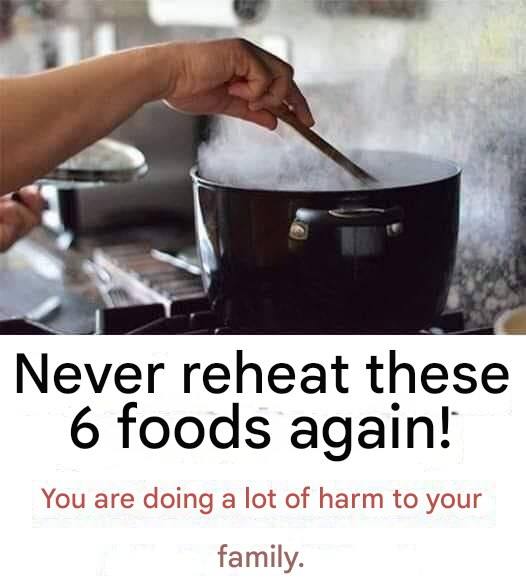ADVERTISEMENT
How to safely store and reheat: Store leftover potatoes in the refrigerator and not at room temperature. If you want to reheat baked potatoes, ensure they are reheated thoroughly and evenly. For mashed potatoes, make sure they reach a high temperature before consuming. Avoid leaving potatoes at room temperature for more than two hours.
4. Leafy Greens (Spinach, Kale, etc.)
Why it’s risky: Reheating leafy greens like spinach, kale, and swiss chard can be dangerous due to the presence of nitrates, which are naturally found in these vegetables. When reheated, these nitrates can convert into nitrites, which can be harmful to your health, especially in large amounts. Nitrites have been linked to an increased risk of certain cancers and can cause an upset stomach if consumed in excess.
How to safely store and reheat: If you plan on reheating leafy greens, avoid reheating them multiple times. It’s best to cook these greens fresh each time to avoid the conversion of nitrates to nitrites. If you must store them, refrigerate them promptly and only reheat them once.
5. Mushrooms
Why it’s risky: Mushrooms contain protein and water, which make them an ideal breeding ground for bacteria if left to sit out. Reheating mushrooms that have been stored improperly can cause stomach upset or food poisoning. Additionally, when reheated, mushrooms can lose their texture and flavor, making them unpleasant to eat.
How to safely store and reheat: Mushrooms should be stored in the refrigerator and used within a day or two of cooking. When reheating, ensure they are heated evenly and thoroughly to a high temperature to minimize the risk of foodborne illness.
6. Eggs
Why it’s risky: Eggs are delicate when it comes to reheating. When eggs are reheated, especially scrambled or boiled, they can become rubbery or tough, which makes them less palatable. But more concerning is the risk of bacterial growth if eggs are left at room temperature for too long or not heated to the right temperature. Salmonella is a potential risk, particularly with undercooked eggs.
How to safely store and reheat: Store cooked eggs in the refrigerator and reheat them only once. Ensure that the eggs are heated thoroughly to an internal temperature of 165°F (74°C). It’s best to eat eggs fresh to preserve both flavor and safety.
7. Seafood
Why it’s risky: Seafood such as fish, shrimp, and shellfish are highly perishable. If not stored properly, they can develop harmful bacteria and toxins that can cause food poisoning. Reheating seafood can also cause it to lose its texture, becoming rubbery or dry, but the real concern is the potential for bacterial contamination if not stored and reheated at the correct temperatures.
How to safely store and reheat: Refrigerate seafood promptly and consume it within one or two days. When reheating, make sure to heat it until it’s piping hot all the way through. Avoid reheating seafood multiple times.
8. Oils and Fatty Foods
Why it’s risky: Reheating oils and foods that are high in fat, such as fried foods, can be dangerous because it increases the production of acrylamide, a chemical that can form when food is heated at high temperatures. Acrylamide is believed to be a potential carcinogen, and it forms more readily when foods are repeatedly reheated.
How to safely store and reheat: If you must reheat oily or fatty foods, use a low and slow heating method to avoid overheating the oils and generating harmful compounds. It’s best to limit reheating foods that have been deep-fried or heavily cooked in oil.
9. Frozen Foods
Why it’s risky: Reheating frozen foods improperly can lead to uneven heating, which may allow harmful bacteria to survive. Certain frozen foods may also lose their texture and flavor when reheated. For example, frozen vegetables can become mushy, while frozen meats can become dry or overcooked.
How to safely store and reheat: When reheating frozen foods, ensure that they are defrosted properly in the refrigerator before reheating. Always heat frozen foods evenly, and avoid reheating them more than once.
General Tips for Safe Reheating
- Reheat food to the right temperature: Always ensure food reaches a safe internal temperature of 165°F (74°C) to kill harmful bacteria.
- Avoid reheating multiple times: Reheating food more than once can increase the risk of foodborne illness. Only reheat what you plan to eat.
- Store leftovers properly: Refrigerate leftovers within two hours of cooking to prevent bacterial growth. Store leftovers in airtight containers and consume them within a few days.
- Use proper reheating methods: For even reheating, use the stovetop or microwave, but be mindful of using the correct setting to avoid overheating or uneven heating.
Conclusion: Safe Reheating Practices for Better Health
While reheating food can be convenient, it’s important to be mindful of the risks that come with it. By understanding which foods are dangerous to reheat and following the appropriate storage and reheating guidelines, you can reduce your chances of foodborne illness and protect your health. Always prioritize safe food handling practices to ensure that your meals remain as safe and enjoyable as possible.
ADVERTISEMENT
